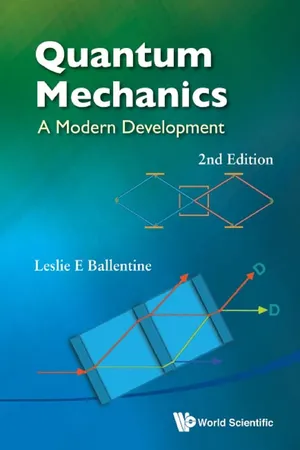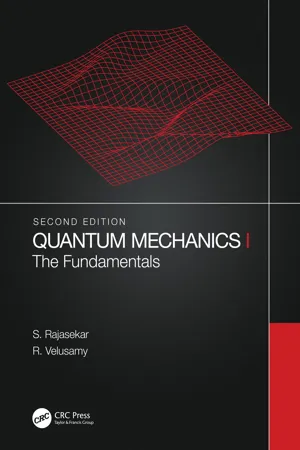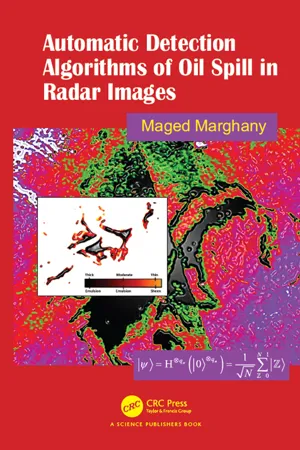Physics
Differential Cross Section
Differential cross section is a measure of the probability of a particle scattering in a particular direction after a collision with another particle. It is used to describe the scattering of particles in a variety of physical processes, including nuclear physics and particle physics. The differential cross section is dependent on the energy and momentum of the particles involved in the collision.
Written by Perlego with AI-assistance
Related key terms
Related key terms
1 of 4
Related key terms
1 of 3
5 Key excerpts on "Differential Cross Section"
- eBook - ePub
Quantum Mechanics
A Modern Development
- Leslie E Ballentine(Author)
- 2014(Publication Date)
- WSPC(Publisher)
Chapter 16
Scattering
The phenomenon of scattering was first mentioned in Sec. 2.1 of this book as an illustration of the fact that quantum mechanics does not predict the outcome of an individual measurement, but rather the statistical distribution or probabilities of all possible outcomes. Scattering is even more important than that illustration would indicate, much of our information about the interaction between particles being derived from scattering experiments. Entire books have been written on the subject of scattering theory, and this chapter will cover only the basic topics.16.1Cross Section
The angular distribution of scattered particles in a particular process is described in terms of a Differential Cross Section . Suppose that a flux ofJiparticles per unit area per unit time is incident on the target. The number of particles per unit time scattered into a narrow cone of solid angle d Ω, centered about the direction whose polar angles with respect to the incident flux are θ and ϕ , will be proportional to the incident fluxJiand to the angular opening d Ω of the cone. Hence it may be written asJi σ(θ , ϕ ) d Ω. The proportionality factor σ (θ , ϕ ) is known as the Differential Cross Section.Suppose that a particle detector is located in the direction (θ , ϕ ), at a sufficiently large distance r from the target so as to be outside of the incident beam.Fig. 16.1 Defining the Differential Cross Section [Eq. (16.1)].If it subtends the solid angle d Ω it will receiveJi σ(θ , ϕ ) d Ω scattered particles per unit time. Dividing this number by the area of the detector, we obtain the flux of scattered particles at the detector,Js=Ji σ(θ , ϕ ) d Ω/r 2 d Ω. Thus the Differential Cross Section can be written asfrom which it is apparent that it has the dimensions of an area. Its value is independent of the distance r from the target to the detector becauseJsis inversely proportional to r 2 . This expression is convenient because the fluxesJsandJi - eBook - ePub
Quantum Mechanics I
The Fundamentals
- S. Rajasekar, R. Velusamy(Authors)
- 2022(Publication Date)
- CRC Press(Publisher)
write d σ d Ω d Ω = Δ N s N i = Number of particles scattered through d Ω per unit time Number of particles incident per unit time per unit area of cross0section. (17.3) It gives nothing but the probability of a particle to be scattered into the angle d Ω. The total number of particles scattered per unit time is then calculated by integrating Eq. (17.2) over the range of Ω: ∫ Δ N s d Ω = ∫ N i d σ d Ω d Ω d Ω = N i ∫ d σ d Ω. (17.4) That is, N s = N i σ, where σ is called total scattering cross-section. We write σ = N s / N i. The cross-sectional area of the nucleus is π R 2 = 7.07 × 10 − 26 A 2 / 3, where R = 1.5 × 10 − 15 m is radius of the nucleus and A is the mass number. For Al 27 the cross-sectional area is 0.588 × 10 − 28 m 2 and for Au 197 it is 2.4 × 10 − 28 m 2. The nuclear cross-sections are typically around 10 − 28 m 2. Cross-sections are often measured in barns (b), where 1barn = 10 − 28 m 2. Cross-sections run from 0 to several 10 5 barns, but a few barns are typical. 17.3 Centre of Mass and Laboratory Coordinates Systems Often the scattering cross-section is experimentally measured and compared with the cross-section derived using theory. There is generally a correction which must be made before the results of the theory and experiment is compared. This correction arises from the necessity of taking into account the recoil of target particle. Let us recall the scattering process. In a laboratory experiment the target is usually a thin metal foil and a narrow beam of particles is directed to fall on it. The particles are scattered by nuclei in the target and their number is counted by suitable detectors kept at various angles. This is shown in Fig. 17.2a. The target is assumed to be stationary after interaction with the incident particle. However, in reality the target particles will not remain stationary, unless they are very massive than the incident particles - eBook - ePub
Charged Particle Optics Theory
An Introduction
- Timothy R. Groves(Author)
- 2017(Publication Date)
- CRC Press(Publisher)
θ.Figure 4.4: Classical elastic scattering geometry.We assume a uniformly dense beam of many particles incident on the scattering center from the left. We expect that the number of scattered particles dN detected at angle ϑ in a time interval dt must be proportional to the product of the incident intensity S0 times the scattered solid angle element dΩ times the time interval dt, i.e.,(4.39) where σ(ϑ) is a proportionality factor which depends on the scattering angle ϑ. This factor contains all relevant information about the details of the scattering process. It is called the Differential Cross Section. Rearranging factors, this is(4.40) The Differential Cross Section is the number of scattered particles per unit solid angle, per unit time, per unit incident intensity. It has units of area. Mathematically, the central problem is to find the Differential Cross Section σ(ϑ).The strength of the scattering and resulting ϑ vary inversely with the distance b, called the impact parameter. The problem is axially symmetric about the z-axis. Considering the range of possible values of b, we therefore write(4.41) where the cross-sectional area element dA0 is an annulus centered on the z-axis. The final solid angle element d - eBook - ePub
- David Bohm(Author)
- 2012(Publication Date)
- Dover Publications(Publisher)
*FIG . 3For the case of hard spheres, σ (θ , ϕ ) is not a function of ϕ . If the particle were nonspherieal in shape, then it is clear that the probability of deflection into different elements of dϕ would be different. The relation between σ (θ , ϕ ) and q (θ ) is, in general,For the case where σ is not a function of ϕ , one obtainsIt is clear from the above definition that, for hard spheres, This means that for hard spheres there is a uniform probability of scattering into any element of solid angle.FIG . 4A typical experimental arrangement in a scattering problem is shown in Fig. 4 . The scattered particles are counted with the aid of the detector. The number of particles scattered into the detector per unit time is j ρσ dx d Ω, where j is the incident current per unit area, and d Ω is the solid angle subtended by the detector at the target. From the measured value of this number, one can calculate σ , if ρ and j are known.For gaseous targets, the experimental problem is usually more difficult, but these difficulties are often overcome in various ways.7. More General Theory of Scattering. So far, we have discussed the scattering process under the assumption that the particles behave as if they are hard elastic spheres. Now, we know that this assumption is not entirely true. For example, the forces between atoms can be described by means of a potential curve as shown in Fig. 5 . The atoms actually attract each other at long distances and repel each other at short distances. Because the repulsive force rises rather sharply as the atoms approach very close to each other, there is some radius, r0 , which may be defined as a rough value of the effective atomic radius, closer than which it is very difficult to bring atoms together. A hard sphere would have a potential that was zero everywhere for r > r 0 but infinite for r < r 0 . Some systems approach hard spheres more closely than do others. For example, with noble gas atoms the attractive forces are very small, while the repulsive forces rise very steeply. As a result, they act very nearly like “hard spheres.” On the other hand, sodium atoms are much “softer” in the sense that the force does not appear so abruptly. The potential between charged particles (V = e 2 /r - Maged Marghany(Author)
- 2019(Publication Date)
- CRC Press(Publisher)
4Quantum Mechanical of Scattering Cross-Section Theory
ABSTRACT: Scattering is the keystone to understand the mechanism of radar imaging. The conventional way of scattering is well addressed in many literature reviews. However, there is a new approach to comprehending the scattering mechanisms. This chapter delivers a new approach based on quantum mechanics. In this view, the Feynman concept for scattering is introduced. Moreover, the chapter has also demonstrated the dependence of the scattering theory on the spin. In this regard, this chapter delivers the correlations between scattering and wavefunction. For more details, the scattering theory is also tackled from the view of quantum particles.4.1 Definitions of Scattering
Scattering is a general physical process where some forms of radiation, such as light, sound or moving particles, are forced to deviate from a straight trajectory by one or more path due to localized non-uniformities in the medium through which they pass. In this regard, the quantum mechanics describe the scattering as a function of atom-photon interaction. In this understanding, the definite detected targets are two incident photons with a certain energy, and two deviate photons with different energies. In this context, the probability of such a process (given the incident and the deviation) to occur is determined by the amplitude associated with this particular Feynman graph (Fig. 4.1 ). It is also worth noting that such a probability is not completely accurate since a single diagram is just one term of the infinite formal perturbative expansion providing the transition amplitude. However, it must not interpret the Feynman graph as a collision process. Figure 4.1 reveals that Positron 1 absorbs B and becomes positron 4, which emits C and becomes positron 3. Furthermore, electron 2 and positron 3 annihilate and producing D [52 , 53 , 54 , 55
Index pages curate the most relevant extracts from our library of academic textbooks. They’ve been created using an in-house natural language model (NLM), each adding context and meaning to key research topics.
Explore more topic indexes
Explore more topic indexes
1 of 6
Explore more topic indexes
1 of 4




